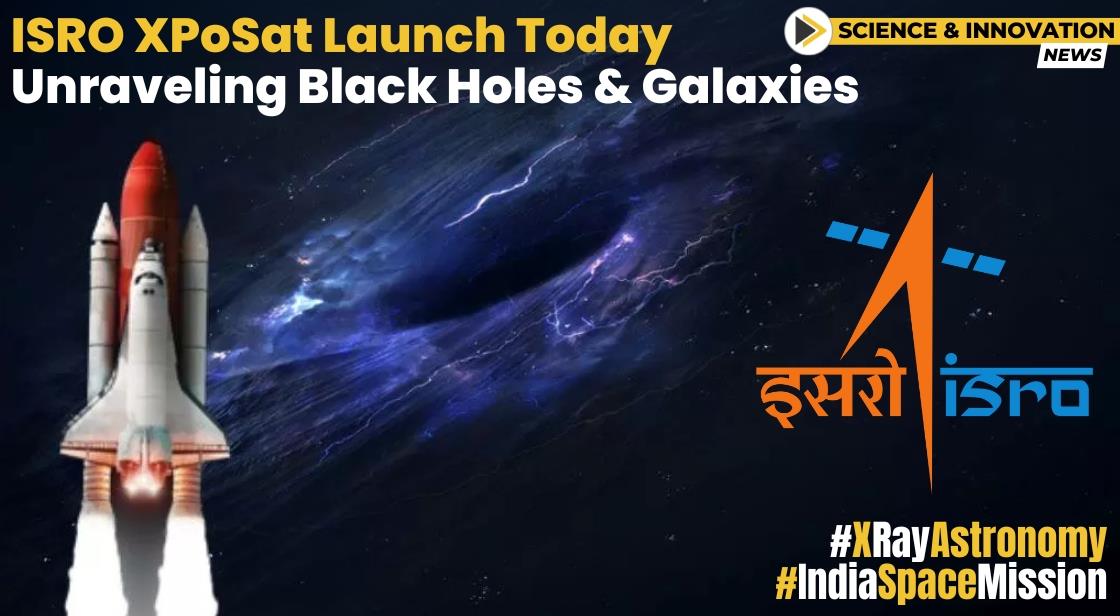ISRO XPoSat launch today: Unraveling Black Holes and Galaxies

News Synopsis
India's space agency, ISRO, achieved a monumental feat on January 1, 2024, with the successful launch of its pioneering X-Ray Polarimeter Satellite (XPoSat). Utilizing the Polar Satellite Launch Vehicle (PSLV) rocket, this mission marks a significant stride in space exploration, aiming to unravel the mysteries of cosmic entities like black holes and galaxies.
Trailblazing Mission Objectives
XPoSat's launch, the 60th mission by ISRO, deployed the primary payload alongside ten other satellites destined for low earth orbits. With a primary focus on probing the polarization of intense X-ray sources in space, XPoSat is the maiden dedicated scientific satellite by ISRO, specifically engineered for research in space-based polarimetry of X-ray emissions from celestial sources.
Milestone in Cosmic Exploration
This mission represents a pivotal moment in India's space endeavors, paralleling NASA's Imaging X-Ray Polarimetry Explorer mission conducted in December 2021. G Madhavan Nair, former ISRO Chairman, hailed the reliability and cost-effectiveness of the PSLV rocket, underscoring its success rate of over 95% globally.
Significance of XPoSat Mission
Nair emphasized the profound scientific significance of this mission, stressing its role in observing fundamental phenomena related to galaxies, black holes, and dying stars. Positioned to illuminate the origins of the universe, XPoSat's observations based on timing and spectroscopy are poised to revolutionize our comprehension of celestial objects' physics.
Global Contributions and Future Prospects
Anticipated to be a boon for the global astronomy community, XPoSat's observations are set to deepen our understanding of celestial marvels like black holes, neutron stars, and active galactic nuclei.
Beyond its scientific implications, this mission holds the potential to spearhead expertise in X-ray polarimetry within India and foster collaborative networks in the astronomy domain.
Unpacking XPoSat's Secrets: Deep Dives into the Latest Facts
Let's delve deeper into those fantastic facts about XPoSat and weave them into an even more compelling narrative:
1. Unraveling the Cosmos with Precision Instruments:
- POLIX: This Polarimeter Instrument in X-rays is the heart of XPoSat, measuring the polarization of celestial X-rays with unprecedented accuracy. Imagine it as a cosmic detective, sifting through light to reveal the hidden orientation and spin of celestial objects.
- XSPECT: This X-ray Spectroscopy and Timing payload acts as a celestial orchestra conductor, precisely measuring the timing and energy of X-ray bursts. By combining POLIX's polarization data with XSPECT's detailed choreography, scientists can reconstruct the dramatic events within black holes and exploding stars.
2. Global Collaboration: Sharing the Cosmic Light:
- XPoSat's journey isn't a solo act. Collaboration with international space agencies like NASA and ESA is already planned, with joint teams analyzing data and dissecting the secrets of the universe together. Imagine scientists around the world peering through the same cosmic window, sharing insights and discoveries that transcend borders.
3. Unveiling the Hidden Faces of Celestial Giants:
- Forget generic "black holes"; XPoSat targets specific cosmic characters. Supermassive black holes lurking in active galactic nuclei, neutron stars spitting out fiery pulses, and the ghostly remnants of supernovae - these are the stars of XPoSat's show. By measuring their polarized light, scientists hope to unveil the hidden structures and dynamics within these enigmatic objects.
4. Inspiring Future Stargazers:
- XPoSat's mission isn't just about celestial discoveries; it's about igniting scientific curiosity on Earth. ISRO plans to utilize XPoSat data for educational outreach programs, creating interactive tools and captivating visualizations that bring the wonders of the cosmos to classrooms and science centers. Imagine students across India embarking on virtual journeys through black holes and galaxies, inspired by XPoSat's cosmic revelations.
5. A Five-Year Cosmic Adventure:
- XPoSat is prepared to spend five years unraveling the universe's mysteries, but this might just be the first act. Based on its performance, the mission could be extended, offering even more opportunities to delve deeper into the celestial unknown.
6. Beyond XPoSat: India's Stellar Odyssey Continues:
- XPoSat isn't a lone star in the Indian space theater. Missions like Aditya-L1, studying the Sun's fiery secrets, and Chandrayaan-3, seeking treasures on the lunar surface, showcase India's unwavering commitment to exploring the cosmos. Each mission adds a new chapter to the epic saga of Indian space exploration.
7. Building a Space Economy:
- XPoSat isn't just a scientific marvel; it's an economic engine. Attracting international collaborations, developing cutting-edge technologies, and fostering a skilled workforce in the space industry – these are just some of the economic benefits XPoSat brings to India. It's a testament to the nation's ambition to not only explore the stars but also harness their potential for sustainable development.
8. Cosmic Guardians: XPoSat Watches Over Earth:
- While XPoSat focuses on distant celestial objects, its observations could have Earthly applications. Studying cosmic phenomena like gamma-ray bursts, which can disrupt satellites and communication systems, could lead to early warning systems and protective measures for our planet. XPoSat, in a way, becomes a cosmic sentinel, watching over Earth from the depths of space.
You May Like









